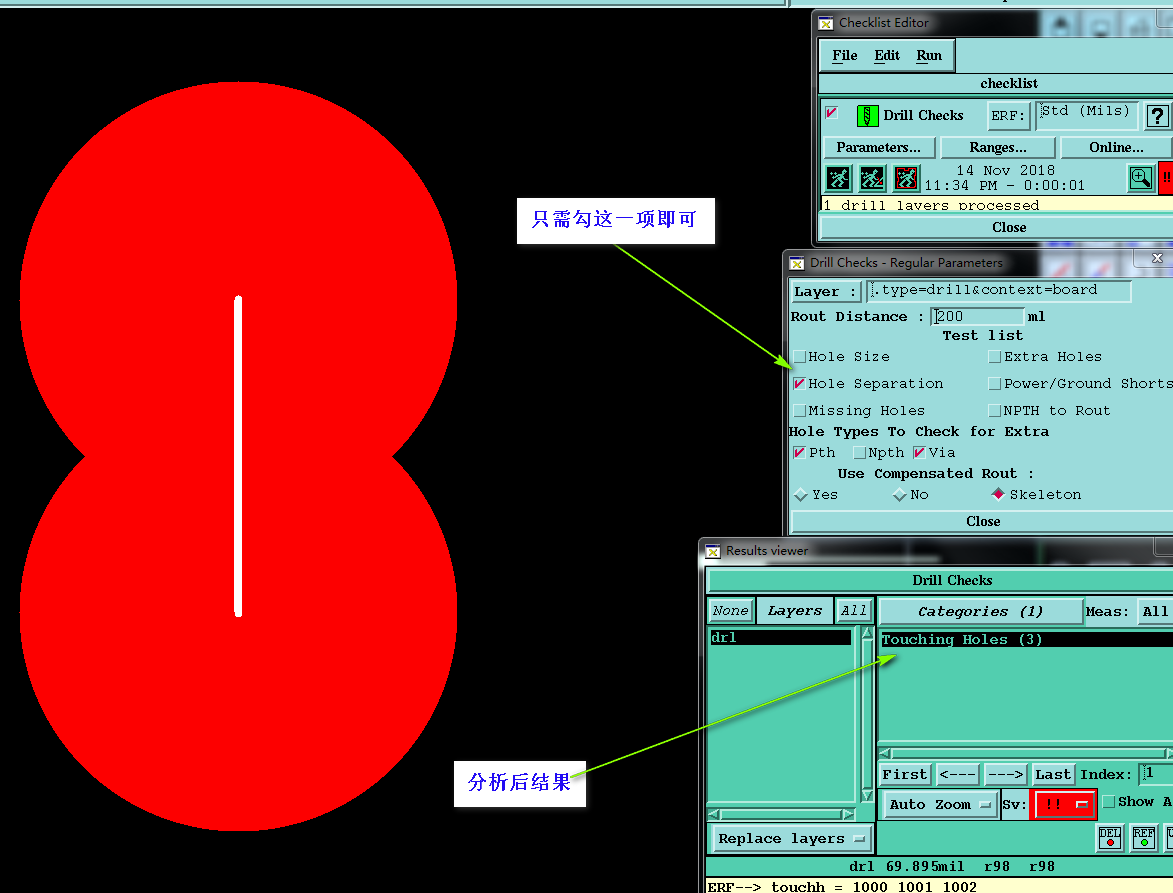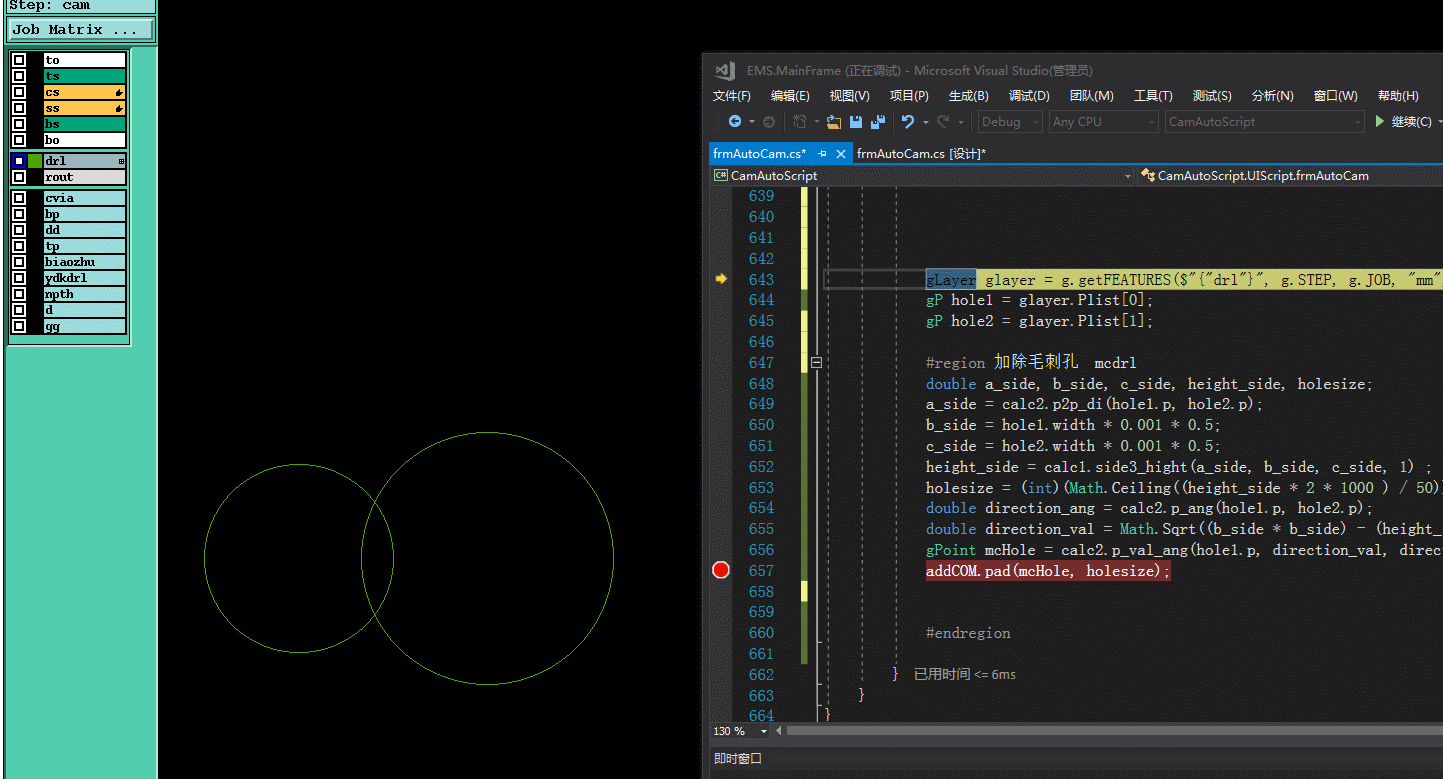PCB genesis連孔加除毛刺孔實現方法
阿新 • • 發佈:2018-11-15
一.為什麼 連孔加除毛刺孔
原因是 PCB板材中含有玻璃纖維, 毛刺產生位置在於2個孔相交位置,由於此處鑽刀受力不均導致纖維切削不斷形成毛刺 ,為了解決這個問題:在鑽完2個連孔後,在相交處再鑽一個孔,並鑽進去一點(常規進去1-2mil),這樣就可以將纖維毛刺去除

PCB同行業毛刺問題處理辦法 鑽孔孔內毛刺問題分析改善報告
二.連孔加除毛刺孔實現原理
求解思路:
1.已知小圓半徑:1.5mm,大圓半徑 2mm,2個點距離3mm
利用海倫公式(三邊求高)求出除塵孔徑半徑:0.8887mm
2.除塵孔半徑 0.8888mm 轉為鑽刀向上取整為1.8mm
3. 求出小圓到大圓方位角,即為0度
求出小圓到毛刺孔距離,即為1.2083mm
4. 以小圓中心,通過方位角0與增量距1.2083mm求出毛刺孔座標

三.C#簡易程式碼實現:
1.加除毛刺孔程式碼(因為有現成的2D庫直接用上來,其實還有一種更簡便的計算公式;這裡不介紹了)

#region 加除毛刺孔 mcdrl double a_side, b_side, c_side, height_side, holesize; a_sideView Code= calc2.p2p_di(hole1.p, hole2.p); b_side = hole1.width * 0.001 * 0.5; c_side = hole2.width * 0.001 * 0.5; height_side = calc1.side3_hight(a_side, b_side, c_side, 1) ; holesize = (int)(Math.Ceiling((height_side * 2 * 1000 ) / 50)) * 50; double direction_ang = calc2.p_ang(hole1.p, hole2.p);double direction_val = Math.Sqrt((b_side * b_side) - (height_side * height_side)); gPoint mcHole = calc2.p_val_ang(hole1.p, direction_val, direction_ang); addCOM.pad(mcHole, holesize); #endregion
2.計算函式

/// <summary> /// 3邊求高 /// </summary> /// <param name="a_side"></param> /// <param name="b_side"></param> /// <param name="c_side"></param> /// <param name="abc"></param> /// <returns></returns> public double side3_hight(double a_side, double b_side, double c_side, int abc = 1) { double p, s; p = (a_side + b_side + c_side) / 2; s = Math.Sqrt(p * (p - a_side) * (p - b_side) * (p - c_side)); if (abc == 1) return (s / a_side ) *2; else if (abc == 2) return (s / b_side) * 2; else return (s / c_side) * 2; } /// <summary> /// 求方位角 /// </summary> /// <param name="ps"></param> /// <param name="pe"></param> /// <returns></returns> public double p_ang(gPoint ps, gPoint pe) { double a_ang = Math.Atan((pe.y - ps.y) / (pe.x - ps.x)) / Math.PI * 180; //象限角 轉方位角 計算所屬象限 並求得方位角 if (pe.x >= ps.x && pe.y >= ps.y) //↗ 第一象限 { return a_ang; } else if (!(pe.x >= ps.x) && pe.y >= ps.y) // ↖ 第二象限 { return a_ang + 180; } else if (!(pe.x >= ps.x) && !(pe.y >= ps.y)) //↙ 第三象限 { return a_ang + 180; } else if (pe.x >= ps.x && !(pe.y >= ps.y)) // ↘ 第四象限 { return a_ang + 360; } else { return a_ang; } }//求方位角 /// <summary> /// 返回兩點之間歐氏距離 /// </summary> /// <param name="p1"></param> /// <param name="p2"></param> /// <returns></returns> public double p2p_di(gPoint p1, gPoint p2) { return Math.Sqrt((p1.x - p2.x) * (p1.x - p2.x) + (p1.y - p2.y) * (p1.y - p2.y)); } /// <summary> /// 求增量座標 /// </summary> /// <param name="ps">起點</param> /// <param name="val">增量值</param> /// <param name="ang_direction">角度</param> /// <returns></returns> public gPoint p_val_ang(gPoint ps, double val, double ang_direction) { gPoint pe; pe.x = ps.x + val * Math.Cos(ang_direction * Math.PI / 180); pe.y = ps.y + val * Math.Sin(ang_direction * Math.PI / 180); return pe; }View Code
3.Point,PAD資料結構

/// <summary> /// PAD 資料型別 /// </summary> public struct gP { public gP(double x_val, double y_val, double width_) { this.p = new gPoint(x_val, y_val); this.negative = false; this.angle = 0; this.mirror = false; this.symbols = "r"; this.attribut = string.Empty; this.width = width_; } public gPoint p; public bool negative;//polarity-- positive negative public double angle; public bool mirror; public string symbols; public string attribut; public double width; public static gP operator +(gP p1, gP p2) { p1.p += p2.p; return p1; } public static gP operator -(gP p1, gP p2) { p1.p -= p2.p; return p1; } } /// <summary> /// 點 資料型別 (XY) /// </summary> public struct gPoint { public gPoint(gPoint p_) { this.x = p_.x; this.y = p_.y; } public gPoint(double x_val, double y_val) { this.x = x_val; this.y = y_val; } public double x; public double y; public static gPoint operator +(gPoint p1, gPoint p2) { p1.x += p2.x; p1.y += p2.y; return p1; } public static gPoint operator -(gPoint p1, gPoint p2) { p1.x -= p2.x; p1.y -= p2.y; return p1; } }View Code
四.在Genesis或Incam中如何判斷是否為連孔
判斷2個孔是否為連孔,可以自己寫演算法實現啦,當然更多人還是會選擇奧寶提供DrillChecklist分析出來的的結果來判斷是否為連孔.因為你自己寫的演算法效率沒有奧寶的效率高呀


五.實現效果


